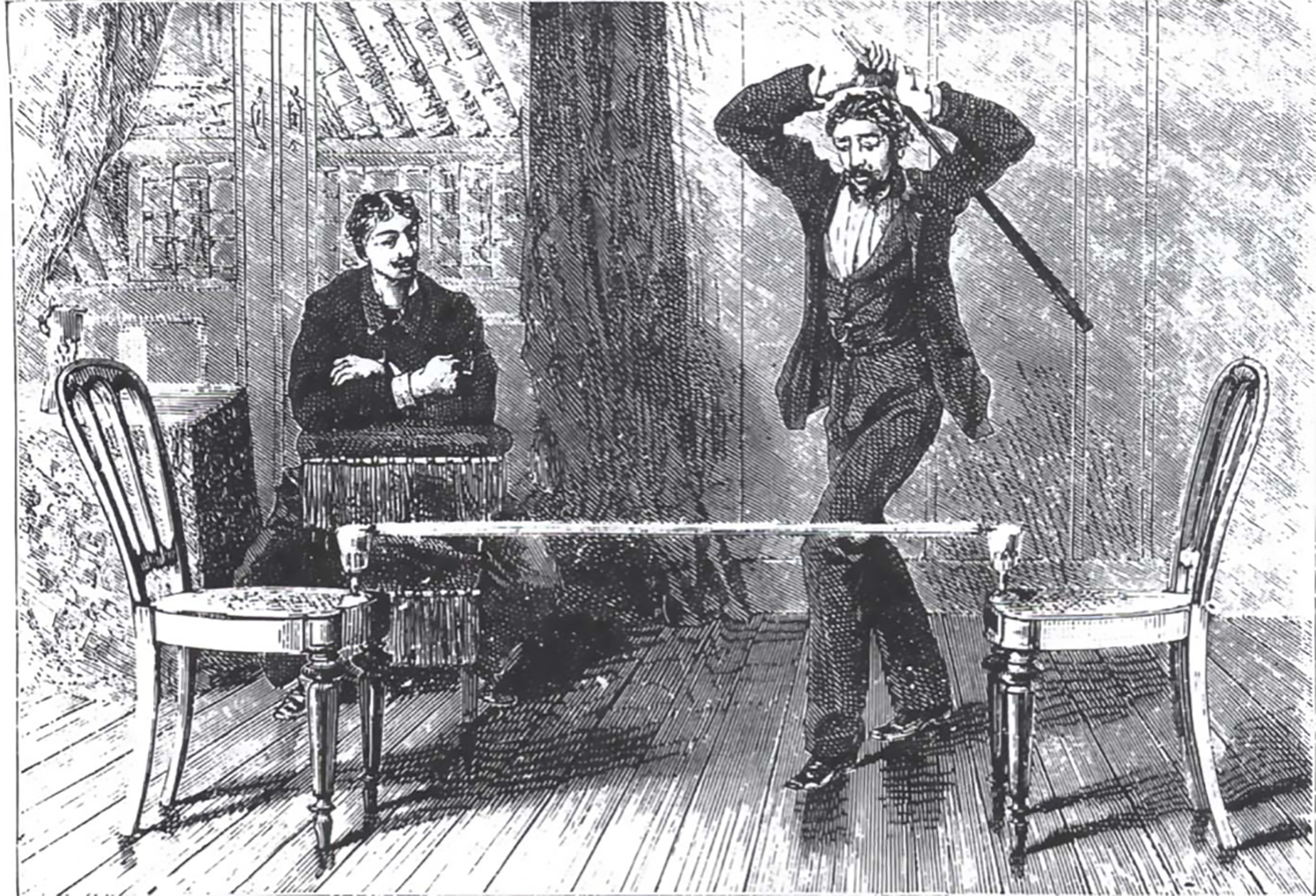20.6. Stick on wine glass#
| Author: | Ed van den Berg |
| Time: | 10 minutes |
| Age group: | 12-18 |
| Concepts: | Forces, inertia |
Introduction#
Imagine a stick with headless nails or needles in each end, resting on fragile wine glasses. Then a hard hit with a club. The stick breaks, but the wine glasses do not. How is that possible?

Fig. 20.17 The demonstration as drawn in a publication from 1881. It was already known in 1532 . Figure taken from https://commons.wikimedia.org/wiki/File:Scientific_amusements(1890)_Experiment_to_illustrate_inertia.jpg (public domain).#
Equipment#
Several sticks of about 1 meter that easily break with a good hit and do not bend endlessly
2 headless nails or better, needles, each inserted into one end of the stick
2 fragile wine glasses
Club (or heavy piece of wood)
Safety glasses
Safety zone of approximately 2 meters
Preparation#
Place the glasses on the edges of two tables that are opposite each other, making the setup as visible as possible. Alternatively, set up the whole setup on an elevated surface, place the glasses on stools on the table for example. Then stand on a chair yourself, as it is easier to hit from there. Place the stick with the needles on the edge of the glass so that only the needles are touching the glass. Make sure that even if the stick does not break, it will not touch the glasses. In that case, only the needles bend, and the glasses remain intact.
If you do this demonstration for the first time, it is necessary to experiment with different sticks until you find a type that consistently and predictably breaks as intended. Once you have a stock of those sticks, little preparation is needed. In the US, broomsticks of about 2.5 cm diameter made of pine wood are used. Other broomsticks might be too hard and too thick. Spruce wood works well.
Procedure#
Make an exaggerated preparation, as if everything could go wrong and as if the demonstrator is unsure if it will all work. For example, move the front students again, just to be safe! If I raise the club and then hit the stick, what will happen to the wine glasses? It is not necessary to have a whole discussion about that question. Then raise the club, lower it a bit, will it work? And then suddenly the hit. Always repeat the experiment with a second stick for those who blinked at the crucial moment or did not believe their eyes.
At an event, you can simply give an explanation (see below). In class, you can start a discussion: How could you explain this? Let the students first mention concepts that might play a role and then speculate further about explanations. Eventually, the teacher will have to provide the explanation.
Alternative setup: hang the stick in two paper rings that are in turn supported by razor blades on their edge. This also works well, the paper does not tear.
Physics background#
When using the right sticks, the glasses will never break (or the paper rings will not be cut). In dozens of demonstrations I have done in the Philippines, the only broken wine glass was due to it falling, not because of the force of the nail. Due to the hit in the middle, the ends of the stick immediately snap upward and apparently exert little to no force on the glasses or paper rings. Mamola and Pollock found in high-speed camera recordings that the ends move upward immediately as soon as the club hits the stick. An extensive study was conducted by , who, through extensive mathematical analysis and subsequent modeling and experiments with force sensors, found that transverse waves generated by the hit do not reach the ends in time. According to him, the ends move at most 1 mm downward before snapping upward.
Explanation (simple): The shock in the middle does not reach the ends before the stick is broken. The particles in the middle separate (the stick breaks) before they can transmit the impulse to the ends .
Follow-up#
Students can investigate this phenomenon further, for example, using an iPhone 6 as a high-speed camera. You can also experiment with slow hits, which will likely go wrong, and with thicker and thinner sticks. article has a lot of math, but it contains literature references to the analysis of karate chops; these will undoubtedly provide interesting ideas for research.
Tip
For several years, this demo was a staple at school visits and events at our center in the Philippines. It was usually the highlight of the show, which may have shown that physics is very spectacular, but not always understandable.
